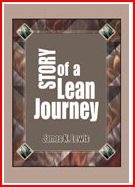Here is a question I asked Jim Lewis, author of the Story of a Lean Journey and co-author of a soon to be released book titled “The Perry Story”.
Joe: Now you’ve talked a lot about the benefits someone can get from Lean by doing it, but how tough is it to achieve? I mean, is it doable? Is it doable in three months? Six months? I could be out of business in six months. Is it something that really can be done in the short term, or is it something that takes a long time?
Jim: Yes to both of those. And let me explain that. Lean is a journey. You’re transforming your business from wherever it is today to a new way of doing business.
It is a journey. Another reason for using an outside person is because usually internal resources don’t have a full comprehension, unless they are Lean experts themselves, they don’t have a full comprehension of the commitment that’s necessary in order to make this journey, and they really don’t know how this journey is going to unfold.
There’s an 80/20 rule that applies to anything and everything, and it applies to Lean as well. The transformation process is not complete until it becomes self?sustainable, where you forget what the old was. You can’t even remember what the old was.
I mention that in my book, once the transformation reaches that point where you can no longer remember what the old way was, then you are well on your way to a successful journey. And that takes probably three to five years before the process becomes the new norm ? the Lean now is the new norm.
Businesses have been doing business the way they have for years, since the Industrial Revolution of the 1850s. So we’ve been ingrained in us this ‘batch ‘ mentality of doing business for so long that it takes a long time to change the culture. And that’s what you’re doing, you’re changing the culture in the organization, and so that takes three to five years.
But the 80?20rule applies to that. You will get immediate results from a Lean Initiative, from day one. As soon as you begin to implement, you get positive results. I usually work with a company, either full?time or part-time depending on the organization for six to eight months.
From day one, I’m weaning myself away from the organization because I don’t want them totally dependent on me. I want them to be able to begin to take ownership and responsibility for the transformation themselves. I’ll usually find a key individual in the organization who I can work with closely, who’s going to take over the mantle as I leave.
That person will take the mantle of responsibility for ensuring that the transformation process continues to move forward until the entire culture is changed.
It’s not just changing the culture of the workers in the organization. The management, the leadership of the organization has to change their culture as well. They’re no longer task managers. They’re going to work in a collaborative way. I’m not talking about self?managed work teams. I’m talking about working with people in a collaborative way, and problem solving, and soliciting input and ideas, and suggestions and recommendations.
Empowering is another one of the E’s. It’s empowering the staff to be able to make change happen in their area of control. Managers are going to be relinquishing some control in that transformation process, where they go to a team?based activity versus a traditional, task?managed operation.
It does take a long time, but the results are immediate. If you can get through that cultural shift change and have a sustainable operation, then Lean becomes the new norm, and you forget where you were.
Related Information:

Comments are closed.